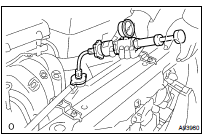Toyota Highlander Service Manual: On-vehicle inspection
1. INSPECT COOLING SYSTEM FOR LEAKS

(a) Remove the radiator cap.
CAUTION: Do not remove the radiator cap while the engine and radiator are still hot. Pressurized, hot engine coolant and steam may be released and cause serious burns.
(b) Fill the radiator with coolant and attach a radiator cap tester.
(c) Warm up the engine.
(d) Using a radiator cap tester, increase the pressure inside the radiator to 118 kPa (1.2 kgf/cm2, 17.1 psi), and check that the pressure does not drop.
If the pressure drops, check the hoses, radiator or water pump for leaks. If no external leaks are found, check the heater core, cylinder block and head.
2. CHECK ENGINE COOLANT LEVEL AT RESERVOIR
(a) The engine coolant level should be between the "LOW" and "FULL" lines when the engine is cold.
If low, check for leaks and add "Toyota Super Long Life Coolant" or similar high quality ethylene glycol based non-silicate, non-amine, non-nitrite, and non-borate coolant with long-life hybrid organic acid technology up to the "FULL" line. Do not use plain water alone.
3. CHECK ENGINE COOLANT QUALITY
(a) Remove the radiator cap.
CAUTION: Do not remove the radiator cap while the engine and radiator are still hot. Pressurized, hot engine coolant and steam may be released and cause serious burns.
(b) Check if there is any excessive deposits of rust or scale around the radiator cap and radiator filler hole.
Also, the coolant should be free from oil.
If excessively dirty, replace the coolant.
(c) Reinstall the radiator cap.
 Inspection
Inspection
1. INSPECT THERMOSTAT
HINT:
The thermostat is numbered with the valve opening temperature
is stamped on the thermostat.
(a) Immerse the thermostat in water and gradually heat the
water.
...
More about Toyota Highlander:
Front seat ASSY LH (power seat type)
COMPONENTS
OVERHAUL
CAUTION:
Wear safety gloves, because the cutting surfaces of the seatback
frame and seat adjuster may
injure your hand.
Work must be started at least 90 seconds after the ignition switch is
turned to the LOCK position
and the negative (-) terminal cable is dis ...

